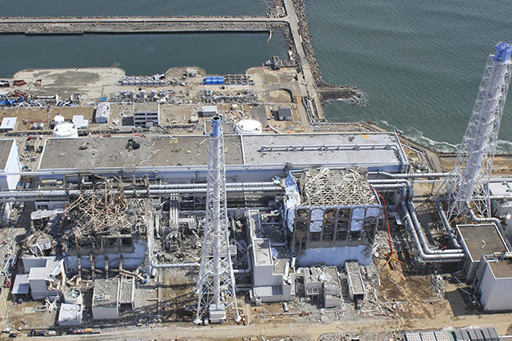3.2.1 What caused the meltdown at Fukushima?
At 14:46 Japanese time on Friday 11 March 2011, a magnitude nine earthquake struck Japan with its epicentre 30km east of the Oshika peninsula and 150 km north-east of the Fukushima Daiichi site.
The earthquake
On the day, only reactors 1, 2 and 3 were running with the other three reactors shutdown for routine inspection. The earthquake produced significant tremors within the site and although some tolerance was built into the design of these reactors, the shocks were large enough to exceed this tolerance in reactors 2, 3 and 5.
The reactors had built-in safety systems that responded to the earthquake by implementing an immediate and automatic shutdown. This was achieved by lowering control rods into the fuel to absorb enough neutrons for fission to cease.
The connections to external power failed but the emergency diesel generators on site successfully kicked in, these were crucial to power the pumps that kept the coolant circulating through the core. Remember that, although the fission had been successfully stopped, the fission products within the fuel elements would be extremely active, creating a great deal of heat from radioactivity.
In addition to the fuel rods situated within, there were spent fuel rods within the building of reactor 4. These also needed cooling due to the concentration of fission products within them.
After the earthquake the safety mechanisms performed well and the power station was in a stable condition, with cores shutdown and able to cool.
The tsunami
The stability within the power station was not to last. The earthquake triggered a huge tsunami and 50 minutes after the earthquake it hit the Daiichi site. A tsunami had been anticipated within the power plant’s design, with a 10m wall built for protection from the sea. Unfortunately, this tsunami was 14m and able to surge over the barrier. Seawater flooded into the plant and its buildings.
Disastrously, the buildings housing the back-up generators were also flooded despite being situated on higher ground. The generators were now unable to power the coolant pumps. Power was now being supplied from batteries that had a lifespan of eight hours maximum.
This left the site both flooded with seawater and with an extremely worrisome situation regarding power for the cooling system. An emergency was declared surrounding the status of generators 1, 2 and 3.
The earthquake and tsunami had also left the local infrastructure badly damaged and it took many hours for additional batteries to arrive on the scene. Portable generators were also acquired but there was little success in connecting these up.
The next few days
In the days after the incident, the workers at the Daiichi site desperately battled to manage the hot cores while the rest of the world looked on from a distance. There were explosions at the plant itself and the issue of containment became a serious concern.
The reactors suffered a series of explosions. These were not nuclear explosions due to fission but chemical explosions caused by the action of heat at the centre of the core on the coolant. The next section describes how the hydrogen explosions occurred and later sections discuss the issue of containment.

